|
Earthquake
Facts and Earthquake Fantasy
Earthquakes are sudden rolling or
shaking events caused by movement under the Earth’s surface.
FACT: An earthquake is the
ground shaking caused by a sudden slip on a fault. Stresses in the
earth's outer layer push the sides of the fault together. Stress builds
up and the rocks slips suddenly, releasing energy in waves that travel
through the earth's crust and cause the shaking that we feel during an
earthquake. An earthquake occurs when plates grind and scrape against
each other. In California, for example, there are two plates the
Pacific Plate (which extends from western California to Japan,
including much of the Pacific Ocean floor) and the North American Plate
(which is most of the North American continent and parts of the
Atlantic Ocean). The Pacific Plate grinds northwestward past the North
American Plate along the San Andreas Fault at a rate of about two
inches per year. Parts of the San Andreas Fault system adapt to this
movement by constant "creep" resulting in many tiny shocks and a few
moderate earth tremors. In other parts, strain can build up for
hundreds of years, producing great earthquakes when it finally
releases. Large and small earthquakes can also occur on faults not
previously recognized; recent earthquakes in Alabama and Virginia are
good examples.
Can “Mega
Quakes” really happen?
THEORETICALLY, YES. REALISTICALLY, NO.
The magnitude of an earthquake is related to the length of the fault on
which it occurs -- the longer the fault, the larger the earthquake. The
San Andreas Fault is only 800 miles long. To generate an earthquake of
10.5 magnitude would require the rupture of a fault that is many times
the length of the San Andreas Fault. No fault long enough to generate a
magnitude 10.5 earthquake is known to exist. The largest earthquake
ever recorded was a magnitude 9.5 on May 22, 1960 in Chile on a fault
that is almost 1,000 miles long. The magnitude scale is open-ended,
meaning that science has not put a limit on how strong an earthquake
could be, and scientists can’t rule out a “Mega
Quake” because they’ve only been measuring
earthquakes for 100 years, a blink of an eye in geologic time. However,
scientists agree that “Mega Quakes” of magnitude 10
or more are implausible.
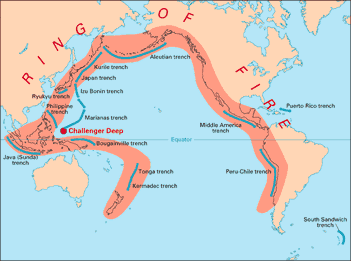 Earthquakes
only occur on the West Coast. Earthquakes
only occur on the West Coast.
FICTION: Earthquakes can strike any location at any
time. But history shows they occur in the same general patterns over
time, principally in three large zones of the earth. The world's
greatest earthquake zone, the circum-Pacific seismic belt, is found
along the rim of the Pacific Ocean, where about 81 percent of the
world's largest earthquakes occur. That belt extends from Chile,
northward along the South American coast through Central America,
Mexico, the West Coast of the United States, the southern part of
Alaska, through the Aleutian Islands to Japan, the Philippine Islands,
New Guinea, the island groups of the Southwest Pacific, and to New
Zealand. The second important belt, the Alpide, extends from Java to
Sumatra through the Himalayas, the Mediterranean, and out into the
Atlantic. This belt accounts for about 17 percent of the world's
largest earthquakes, including some of the most destructive. The third
prominent belt follows the submerged mid-Atlantic ridge. The remaining
shocks are scattered in various areas of the world. Earthquakes in
these prominent seismic zones are taken for granted, but damaging
shocks occur occasionally outside these areas. Examples in the United
States are New Madrid, Missouri, and Charleston, South Carolina. Many
decades to centuries, however, usually elapse between such destructive
shocks.
The 1906 San Francisco earthquake
was the deadliest ever.
FICTION: Though well known, the magnitude 7.8 San
Francisco earthquake and ensuring fire killed 3,000 and razed large
sections of the city. It was the most deadly in U.S. history, but that
doesn’t make it the worst the world has seen, by far. The
deadliest earthquake in recorded history struck Shensi province in
China in 1556, killing about 830,000 people. The 1976 magnitude 7.8
earthquake which struck Tangshan, China killed somewhere between
250,000 and 800,000 people. In 2003, the magnitude 6.5 earthquake in
Bam, Iran killed more than 40,000 people. The earthquake in Chile on
May 22, 1960, is the strongest in the world with magnitude 9.5, and
killed more than 4,000. For the record, the largest U.S. earthquake
occurred on March 28, 1964, in Alaska. It was a magnitude 9.2 quake and
took 131 lives.
California has the most earthquakes
in the United States.
PARTIALLY FACT: Alaska registers the most earthquakes in
a given year, with California placing second. California, however, has
the most damaging earthquakes because of its greater population and
extensive infrastructure. Most of Alaska’s large earthquakes
occur in remote locations such as along the Aleutian Island chain.
Florida and North Dakota have the fewest earthquakes each year.
Earthquakes can occur just below the surface or deep below the surface.
FACT: Earthquakes occur in the crust or upper mantle, from the earth's
surface to about 500 miles below the surface. Seismologists use
earthquakes to study the interior of the earth and to pinpoint faults
and geologic structures such as the core-mantle boundary, subduction
zones, and the subsurface extent of the San Andreas Fault. Using
earthquakes and waves from earthquakes, scientist can see all of the
earth’s interior.
The ground can open up during an
earthquake.
FICTION: A popular cinematic and literary device is a
fault that opens during an earthquake to swallow up an inconvenient
character. But unfortunately for principled writers, gaping faults
exist only in movies and novels. The ground moves across a fault during
an earthquake, not away from it. If the fault could open, there would
be no friction. Without friction, there would be no earthquake. Shallow
crevasses can form during earthquake induced landslides, lateral
spreads, or other types of ground failures. Faults, however, do not
gape open during an earthquake.
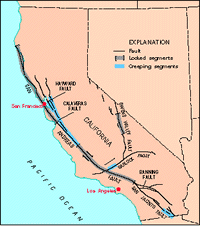 California
will eventually fall into the ocean. California
will eventually fall into the ocean.
FICTION: The ocean is not a great hole into which
California can fall, but it is itself land at a somewhat lower
elevation with water above it. It’s absolutely impossible
that California will be swept out to sea. Instead, southwestern
California is moving horizontally northward towards Alaska as it slides
past central and eastern California. The dividing point is the San
Andreas fault system, which extends from the Salton Sea in the south to
Cape Mendocino in the north. This 800 mile long fault is the boundary
between the Pacific Plate and North American Plate. The Pacific Plate
is moving to the northwest with respect to the North American Plate at
approximately 46 millimeters (two inches) per year (the rate your
fingernails grow). At this rate, Los Angeles and San Francisco will one
day (about 15 million years from now) be next-door neighbors, and in an
additional 70 million years, Los Angeles residents will find themselves
with an Alaska zip code!
An “Aftershock”
can be greater than the initial earthquake.
PARTIALLY FACT: “Foreshock" and "aftershock"
are relative terms. Foreshocks are earthquakes that precede larger
earthquakes in the same location. Aftershocks are smaller earthquakes
that occur in the same general area during the days to years following
a larger event or "main shock”. So if an
“aftershock” is bigger than its “main
shock”, we change the names and call the first one the
foreshock and the large “aftershock” becomes the
main shock. Most aftershocks occur on the same fault as the main shock,
but other faults nearby and extensions of the main shock fault will
also produce aftershocks. Historically, deep earthquakes are much less
likely to be followed by aftershocks than are shallow earthquakes.
Two major earthquakes occurred on
the same day, so they must be related.
NOT LIKELY: Often, people wonder if an earthquake in
Alaska may have triggered an earthquake in California; or if an
earthquake in Chile is related to an earthquake that occurred a week
later in Mexico. Over long distances, the answer is no. Even the
Earth's rocky crust is not rigid enough to transfer stress efficiently
over thousands of miles. There is evidence to suggest that earthquakes
in one area can trigger seismic activity within a few hundred miles,
including aftershocks clustered near the main shock. There is also
evidence that some major earthquakes manage to trigger seismicity over
much greater distances (thousands of miles), but these triggered quakes
are small and very short lived.
People can cause earthquakes.
PARTIALLY FACT: Earthquakes induced by human activity
have been documented in a few locations in the United States, Japan,
and Canada. The cause was injection of fluids into deep wells for waste
disposal and secondary recovery of oil, and the filling of large
reservoirs for water supplies. Most of these earthquakes were minor.
Deep mining can cause small to moderate quakes and nuclear testing has
caused small earthquakes in the immediate area surrounding the test
site, but other human activities have not been shown to trigger
subsequent earthquakes. Earthquakes are part of a global tectonic
process that generally occurs well beyond the influence or control of
humans. The focus (point of origin) of an earthquake is typically tens
to hundreds of miles underground, and the scale and force necessary to
produce earthquakes are well beyond our daily lives.
 People can stop earthquakes. People can stop earthquakes.
FICTION: We cannot prevent earthquakes from happening
(or stop them once they’ve started). However, we can
significantly mitigate their effects by characterizing the hazard
(e.g., identifying earthquake faults, unconsolidated sediment likely to
amplify earthquake waves, and unstable land prone to sliding or
liquefying during strong shaking), building safer structures, and
preparing in advance by taking preventative measures and knowing how to
respond.
Nuclear explosions can start or stop
earthquakes.
FICTION: Scientists agree that even large nuclear
explosions have little effect on seismicity outside the area of the
blast itself. The largest underground thermonuclear tests conducted by
the United States were detonated in Amchitka at the western end of the
Aleutian Islands, and the largest of these was the 5 megaton test
code-named Cannikin that occurred on November 6, 1971 that did not
trigger any earthquakes in the seismically active Aleutian Islands. On
January 19, 1968, a thermonuclear test, code-named Faultless, took
place in central Nevada. The code-name turned out to be a poor choice
because a fresh fault rupture some 4,000 feet long was produced.
Seismograph records showed that the seismic waves produced by the fault
movement were much less energetic than those produced directly by the
nuclear explosion. Locally, there were some minor earthquakes
surrounding the blasts that released small amounts of energy.
Scientists looked at the rate of earthquake occurrence in northern
California, not far from the test site, at the times of the tests and
found nothing to connect the testing with earthquakes in the area.
You can prevent large earthquakes by
making lots of small ones, or by "lubricating" the fault with water
FICTION: Seismologists have observed that for every
magnitude 6 earthquake there are about 10 of magnitude 5, 100 of
magnitude 4, 1,000 of magnitude 3, and so forth as the events get
smaller and smaller. This sounds like a lot of small earthquakes, but
there are never enough small ones to eliminate the occasional large
event. It would take 32 magnitude 5's, 1000 magnitude 4's, and 32,000
magnitude 3's to equal the energy of one magnitude 6 event. So, even
though we always record many more small events than large ones, there
are far too few to eliminate the need for the occasional large
earthquake. As for "lubricating" faults with water or some other
substance, if anything, this would have the opposite effect. Injecting
high- pressure fluids deep into the ground is known to be able to
trigger earthquakes—to cause them to occur sooner than would
have been the case without the injection. This would be a dangerous
pursuit in any populated area, as one might trigger a damaging
earthquake.
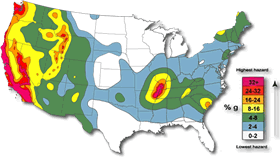 We can predict earthquakes. We can predict earthquakes.
FICTION: Earthquake prediction is the holy grail for
earthquake scientists, but there currently is no accepted method to
accomplish the goal of predicting the time, place and magnitude of an
impending quake. Research into earthquake prediction continues.
However, the USGS approach has been to focus on providing long-range
forecasts of the likelihood locations and impacts of damaging
earthquakes. For example, scientists estimate that over the next 30
years the probability of a major earthquake occurring in the San
Francisco Bay area is 62%, and 60% in Southern California. Scientists
are also able to predict the type of ground motion to expect based on
the geology and the history of earthquake activity of the region.
Engineers and building code developers use these models of site
response to improve the safety of structures, thereby reducing the
ultimate earthquake risk.
Animals can predict earthquakes.
FICTION: Changes in animal behavior cannot be used to
predict earthquakes. Even though there have been documented cases of
unusual animal behavior prior to earthquakes, a reproducible connection
between a specific behavior and the occurrence of an earthquake has not
been made. Because of their finely tuned senses, animals can often feel
the earthquake at its earliest stages before the humans around it can.
This feeds the myth that the animal knew the earthquake was coming. But
animals also change their behavior for many reasons, and given that an
earthquake can shake millions of people, it is likely that a few of
their pets will, by chance, be acting strangely before an earthquake.
Some people can sense that an
earthquake is about to happen.
MAYBE: There is no scientific explanation for the
symptoms some people claim to have preceding an earthquake, and more
often than not there is no earthquake following the symptoms.
It’s been raining a lot,
or very hot--it must be earthquake weather!
FICTION: Many people believe that earthquakes are more
common in certain kinds of weather. In fact, no correlation with
weather has been found. Earthquakes begin many kilometers (miles) below
the region affected by surface weather. People tend to notice
earthquakes that fit the pattern and forget the ones that don't. Also,
every region of the world has a story about earthquake weather, but the
type of weather is whatever they had for their most memorable
earthquake.
 The Golden Gate
Bridge, Seattle Space Needle and other buildings will all eventually
fall during an earthquake. The Golden Gate
Bridge, Seattle Space Needle and other buildings will all eventually
fall during an earthquake.
NOT LIKELY: Architects and engineers are using knowledge
learned from past earthquakes to make roads, bridges, and buildings
safer in the event of major earthquakes. Local officials are also
enacting new building codes to ensure new buildings are built with
earthquake safety in mind. This includes both improving the design of
new buildings and bridges as well as strengthening older units to
incorporate the latest advances in seismic and structural engineering.
Landmark buildings and infrastructure, as well as houses, apartments,
hospitals, schools and other public and private facilities in
earthquake prone areas can be at risk. But the best building codes in
the world do nothing for buildings built before that code was enacted.
While the codes have been updated, the older buildings are still in
place. Fixing problems in older buildings—also known as
retrofitting—is the responsibility of the building's owner.
Earthquakes don’t kill
people, buildings and their contents do.
FACT: The greatest risk in an earthquake is the severity
of the shaking it causes to manmade and natural structures and the
contents within these that may fail or fall and injure or kill people.
There have been large earthquakes with very little damage because they
caused little shaking and/or buildings were built to withstand that
shaking. In other cases, smaller earthquakes have caused great shaking
and/or buildings collapsed that were never designed or built to survive
shaking. Much depends on two variables: geology and engineering. From
place to place, there are great differences in the geology at and below
the ground surface. Different kinds of geology will do different things
in earthquakes. For example, shaking at a site with soft sediments can
last 3 times as long as shaking at a stable bedrock site such as one
composed of granite. Local soil conditions also play a role, as certain
soils greatly amplify the shaking in an earthquake. Seismic waves
travel at different speeds in different types of rocks. Passing from
rock to soil, the waves slow down but get bigger. A soft, loose soil
will shake more intensely than hard rock at the same distance from the
same earthquake. The looser and thicker the soil is, the greater the
energy movement will be. Fires are another major risk during
earthquakes as gas lines may be damaged and particularly hazardous.
During an earthquake you should head
for the doorway.
FICTION: That’s outdated advice. In past
earthquakes in unreinforced masonry structures and adobe homes, the
door frame may have been the only thing left standing in the aftermath
of an earthquake. Hence, it was thought that safety could be found by
standing in doorways. In modern homes doorways are no stronger than any
other parts of the house and usually have doors that will swing and can
injure you. YOU ARE SAFER PRACTICING THE “DROP, COVER, AND
HOLD” maneuver under a sturdy piece of furniture like a
strong desk or table. If indoors, stay there. Drop to the floor, make
yourself small and get under a desk or table or stand in a corner. If
outdoors, get into an open area away from trees, buildings, walls and
power lines. If in a high-rise building, stay away from windows and
outside walls, stay out of elevators, and get under a table. If
driving, pull over to the side of the road and stop. Avoid overpasses
and power lines. Stay inside your car until the shaking is over. If in
a crowded public place, do not rush for the doors. Crouch and cover
your head and neck with your hands and arms. You should practice the
“DROP, COVER AND HOLD” method at work and at home
at least twice a year.
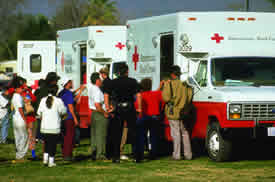 Everyone will panic during
the Big One. Everyone will panic during
the Big One.
FICTION: A common belief is that people always panic and
run around madly during and after earthquakes, creating more danger for
themselves and others. Actually, research shows that people usually
take protective actions and help others both during and after the
shaking. Most people don't get too shaken up about being shaken up!
You can’t plan ahead for
an earthquake.
FICTION: There are plenty of things you can do right now
to prepare if you live in an earthquake-prone area.
1. Make sure each member of your family knows what to do no matter
where they are when earthquakes occur:
o Establish a meeting place where you can all reunite afterward.
o Find out about earthquake plans developed by children's school or day
care.
o Remember transportation may be disrupted, so keep some emergency
supplies--food, liquids, and comfortable shoes, for example--at work.
2. KNOW where your gas, electric and water main shutoffs are and how to
turn them off if there is a leak or electrical short. Make sure older
members of the family can shut off utilities.
3. LOCATE your nearest fire and police stations and emergency medical
facility.
4. TALK to your neighbors--how could they help you, or you them after
an earthquake?
5. TAKE Red Cross First Aid and CPR Training Course.
6. MAKE your disaster supply kit. Beyond the usual flashlights,
batteries and radios, include a first-aid kit; work gloves; sturdy
shoes or boots; a week’s supply of any presciption
medications you or your family might need; credit card and cash;
personal identifcation; extra set of keys; matches in a waterproof
container; map of your area; phone numbers of family and other
important people (doctors, veterinarians, etc.); copies of insurance
policies and other important documents; special needs equipment
(diapers, baby formula, hearing aid batteries; spare eyeglasses, etc.);
three gallons of water per person; three-day supply of food per person;
hand tools; a portable ABC fire extinguisher; sanitation supplies for
you and your family; entertainment (toys, books, coloring books and
crayons, playing cards)
7: BOLT bookcases, china cabinets, tall furniture, file cabinets, etc.
to wall studs. Brace or anchor heavy electronics and other heavy items.
Secure items that might fall. Move heavy or fragile items to lower
shelves. Fasten drawers and cabinet doors with latches or locks. Brace
overhead light fixtures. Strap your water heater to wall studs and bolt
down any gas appliances. Look for other non-structural steps you can
take in your home and workplace to reduce your chances for injury and
loss.
8. ASK AN ENGINEER about the seismic safety of your home and/or
business. It’s well known that unreinforced masonry
structures can fail quickly during earthquakes. An inspection by a
structural engineer now can help you decide if retrofitting will help
your property withstand shaking.
USGS is a worldwide leader in
earthquake hazard research, information and mitigation.
FACT: The U.S. Geological Survey performs the following
functions related to earthquake hazard mitigation:
Receives, analyzes, maintains, and distributes data on earthquake
activity worldwide. Seismograph stations located around the country and
the world are linked in real-time to USGS offices and to analysis
centers run by our partner institutions that continuously monitor,
detect and locate earthquake activity.
Provides rapid notification of earthquake events to civil defense and
government officials in the affected area, and to the public through
the Internet and news media.
Produces regional assessments of earthquake hazards in conjunction with
State and local governments. This information is used by: local
planners and building officials in setting appropriate building and
retrofitting standards, government and civil defense officials in
planning for disaster recovery; professionals conducting detailed site
assessments; and researchers engaged in engineering and seismologic
research.
Engages in basic research to learn more about the nature of earthquake
activity.
Provides education on earthquake hazards and safety to the public by
publishing and distributing literature, and through a variety of other
outreach efforts.
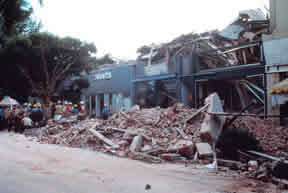 But
more can be done. But
more can be done.
ABSOLUTELY: Earthquakes pose a significant risk to 75
million Americans in 39 states. The USGS is the only Federal agency
with responsibility for recording and reporting earthquake activity
nationwide. Citizens, emergency responders and engineers rely on USGS
for accurate and timely information on where an earthquake occurred,
how much the ground shook in different locations and what is the
likelihood of future significant ground shaking. USGS is working to
improve its earthquake monitoring and reporting capabilities through
the Advanced National Seismic System (ANSS). In the past three years,
USGS has installed about 300 new earthquake- monitoring instruments in
the San Francisco, Seattle, Salt Lake City, Anchorage, Reno, Las Vegas
and Memphis areas. Full implementation of the ANSS will result in
nearly 7,000 new high-tech instruments in the ground or in buildings.
And once in place, the ANSS will provide emergency personnel with near
real-time information on the intensity and distribution of ground
shaking that can be used to guide emergency response efforts.
Similarly, information on building shaking will equip engineers with
the data they need to improve building designs in the future.
There’s great information
available online about preparing for an earthquake
FACT! There are literally hundreds of websites that
focus on earthquake safety. For more factual information on
earthquakes, earthquake myths and earthquake preparedness, see the Earthquakes,
“Mega-quakes,” and the Movies sheet that
accompanies this sheet and visit:
|

